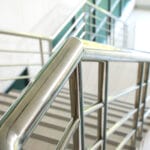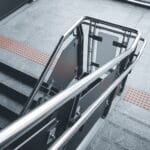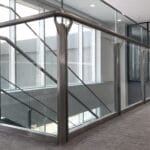Understanding handrail height
Why is handrail height important?
Handrail height is crucial for ensuring user safety and comfort. The right height provides stable support and balance for individuals as they ascend or descend stairs, reducing the risk of falls and injuries.
It caters to a wide range of users, including children, adults, and those with mobility challenges, ensuring the handrail is within easy reach for most people.
What are the standard handrail heights?
Standard handrail heights are typically between 34 and 38 inches (about 86 to 97 cm) from the stair nosing or ramp surface. These measurements are established based on average human heights and ergonomic factors to accommodate the majority of users.
Compliance with these standards ensures accessibility, safety, and comfort, making handrails effective support features in various environments.
Legal requirements and codes
What do building codes say about handrail height?
Building codes generally specify that handrail heights on stairs and ramps should be between 34 and 38 inches from the upper surface of the handrail to the surface of the tread or ramp. These codes are designed to ensure safety and accessibility, taking into account the average person’s height and reach for optimal support and stability.
How do regulations vary by region?
Regulations on handrail height can vary by region due to differences in local building codes and standards. Some areas might have slightly different requirements based on historical data, population demographics, or specific safety studies. For instance, residential buildings might have slightly more lenient standards compared to commercial or public buildings, which often adhere to stricter guidelines to accommodate a broader range of users, including those with disabilities. It’s important for builders and property owners to consult their local building codes to ensure compliance and safety in their specific location.
Measuring and adjusting handrail height
How to measure handrail height accurately?
To measure handrail height accurately, start from the stair tread’s leading edge or the ramp’s surface directly below the handrail. Use a tape measure to extend vertically up to the top of the handrail. Ensure the tape measure is perpendicular to the tread or ramp surface to get an accurate reading. Repeat this process at several points along the handrail to ensure consistency, especially if the stairs or ramp slope varies.
When should you adjust handrail height?
Handrail height should be adjusted if it falls outside the recommended range of 34 to 38 inches, which could compromise safety and comfort. Adjustments might also be necessary if regulations change or if the handrail is being adapted for a specific user group, such as children in schools or individuals with mobility issues in healthcare facilities. Additionally, if renovations alter the stair or ramp dimensions, it’s important to reevaluate and possibly adjust the handrail height to maintain compliance and ensure user safety.
Handrail height for different settings
What’s the ideal height for residential handrails?
The ideal height for residential handrails typically falls within the standard range of 34 to 38 inches from the stair nosing or ramp surface to the top of the handrail. This range is designed to accommodate a broad spectrum of users, providing a comfortable and safe grip height for most adults and older children. In homes, there might be some flexibility to adjust this height slightly based on the residents’ preferences and needs, especially if the home is not subject to strict public building codes.
How does handrail height differ in commercial spaces?
In commercial spaces, handrail height requirements might be more stringent and are often strictly enforced to ensure public safety and accessibility. Commercial and public buildings, including offices, shopping centers, and public institutions, must also comply with the Americans with Disabilities Act (ADA) in the U.S. or similar regulations in other countries, which might dictate additional specifications. These environments might require handrails on both sides of stairs and ramps, and in some cases, specific handrail designs that ensure usability for a wider range of individuals, including those with disabilities.
Impact of handrail height on safety
How does height affect handrail safety?
Handrail height directly impacts safety by influencing the ease and security with which users can grasp and use the handrail. An optimal height allows individuals to comfortably and firmly grip the handrail, providing necessary support and balance while navigating stairs or ramps. This support is crucial for preventing falls and ensuring stability, especially for those with limited mobility or balance issues.
Can incorrect handrail height lead to accidents?
Incorrect handrail height can indeed lead to accidents. If a handrail is too high, shorter individuals or children might not be able to reach it easily, reducing its effectiveness as a support tool. Conversely, a handrail that is too low can cause taller individuals to stoop to grip it, potentially leading to imbalance or strain, which also increases the risk of falls. Ensuring that handrail height falls within the recommended range is essential for maximizing safety and accessibility for all users.
Customization and compliance
Can you customize handrail height and still be compliant?
Yes, you can customize handrail height and still be compliant, provided your design falls within the range specified by local building codes and safety standards. Customization allows for personal preferences or specific user needs to be addressed while maintaining safety and legal requirements.
Tips for ensuring custom handrails meet safety standards
- Research Local Codes: Start by understanding the handrail height requirements in your area. Building codes can vary, so it’s crucial to know the regulations that apply to your specific location.
- Consider User Needs: If designing for a particular group, such as children or individuals with disabilities, consider their specific needs while staying within the legal height range.
- Quality Materials: Use high-quality, durable materials that can withstand regular use and environmental factors, ensuring the handrail remains stable and secure over time.
- Professional Consultation: Especially for unique or complex designs, consulting with a building inspector or a professional experienced in ADA compliance can help ensure your custom handrail meets all necessary standards.
- Regular Testing: Once installed, test the handrail under various conditions to ensure it provides adequate support and stability. Make adjustments as needed to maintain safety and compliance.
- Documentation: Keep detailed records of your design and installation process, including how you’ve adhered to local codes and standards. This documentation can be valuable for inspections or if regulations change.
By following these guidelines, you can achieve a handrail design that is both personalized and in line with safety requirements, ensuring it serves its primary function effectively.
Professional installation and advice
Why consult professionals for handrail installation?
Consulting professionals for handrail installation is a crucial step in ensuring the safety, compliance, and quality of your project. At Metanox, we bring a wealth of expertise and experience to every installation, ensuring that your handrails are not only aesthetically pleasing but also structurally sound and in line with all relevant building codes and standards.
How can experts ensure compliance and safety?
Our team of experts is well-versed in the specific requirements for handrail height, materials, and design across various environments, be it residential, commercial, or public spaces. By choosing Metanox for your handrail installation, you benefit from:
- Expert Guidance: We provide personalized consultations to understand your needs and recommend the best solutions that align with safety regulations and your design preferences.
- Compliance Assurance: Our in-depth knowledge of local and national building codes ensures that your handrails meet all legal requirements, avoiding potential legal issues or the need for costly adjustments down the line.
- Quality Craftsmanship: Metanox prides itself on delivering high-quality installations, using the best materials and techniques to ensure durability, safety, and a flawless finish.
- Risk Management: Professional installation minimizes the risk of accidents during and after installation, protecting you from potential liabilities and ensuring the safety of all users.
- Time and Cost Efficiency: Our experience allows us to complete installations efficiently, reducing the time and potential extra costs associated with DIY or inexperienced installations.
At Metanox, we are committed to providing you with handrail solutions that are safe, compliant, and perfectly integrated into your space. Trust us to handle the complexities of installation, allowing you to enjoy peace of mind and a superior end result.


















